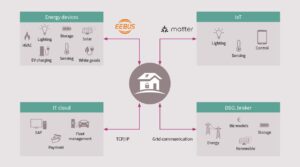A key way to address the global trends of a growing percentage of volatile renewable energy sources and increasing electrification in mobility is to improve the system integration of electricity consumers from all sectors. Implementation requires holistic thinking: from green energy generation, to stable and efficient grid infrastructure, to storage and consumption.
Bidirectional charging contributes significantly to this, for example, by allowing the electricity stored in an electric vehicle's battery to be used to power the grid or household electrical appliances when needed. However, energy generators and consumer devices need a standardized language to communicate.
 As a solution provider, Infineon Technologies is interested in a standardized communication flow for the entire energy control chain. Therefore, the company joined EEBus, an initiative that promotes the standardization of interfaces to allow uniform communication between the energy generator and end user devices.
As a solution provider, Infineon Technologies is interested in a standardized communication flow for the entire energy control chain. Therefore, the company joined EEBus, an initiative that promotes the standardization of interfaces to allow uniform communication between the energy generator and end user devices.
“This principle of a unified energy ecosystem has been the basic philosophy of the EEBus Initiative since the beginning. We offer an open solution to all market participants instead of another isolated proprietary solution”, said Dr. Robert Böhm, Managing Director of the EEBus Initiative eV “With EEBus we develop and standardize a dynamically flexible interface on behalf of the industry and provide a global standard for communication.”
This initiative brings together international companies and associations from different sectors, such as devices and systems relevant to energy, energy supply, network operation and information and communication technology. Infineon is the first semiconductor company to join the initiative.
“The continuous and collaborative coordination of members in eye-level workgroups is creating a unified, vendor-agnostic communications solution that is essential for bi-directional charging and a decentralized power grid,” said Andreas Urschitz, chief marketing officer at Infineon . “With EEBus’ special focus on power management, end-user bidirectional devices can be integrated into the smart grid easily and efficiently.”
EEBus as a uniform standard
EEBus is a standardized, manufacturer-independent language for exchanging power and application-relevant information that can be used free of charge. The standards-based language enables proper functioning of all devices even during power outages and provides plug-and-play solutions for residential and commercial applications.
The EEBus Initiative generally distinguishes between the content, namely the data model that is transmitted, and the type of transmission, respectively, the communication path. The EEBus “SPINE” (Smart Premises Interoperable Neutral-Message Exchange) data model can be transported over various communication paths and protocols. One possible transport protocol is the IP-based “SHIP” (Smart home IP), which is based on widely used RFCs and can be used in existing IP infrastructure.
To ensure maximum flexibility, the EEBus architecture is based on the Smart Grid Architecture Model (SGAM) and offers solutions for several layers.
Regardless of previously used communications technologies or industry affiliation, companies can use SPINE to offer their services or platforms and potentially control millions of energy-relevant devices or, as device manufacturers, intelligently and interoperably connect devices. its own products to a larger ecosystem.
More information about the EEBus eV Initiative is available here.

